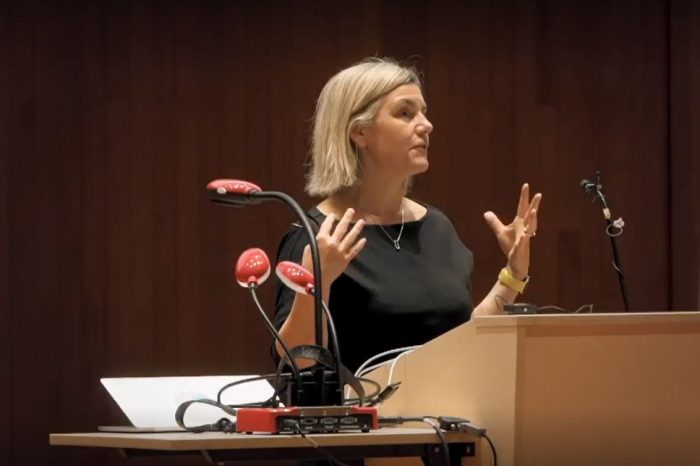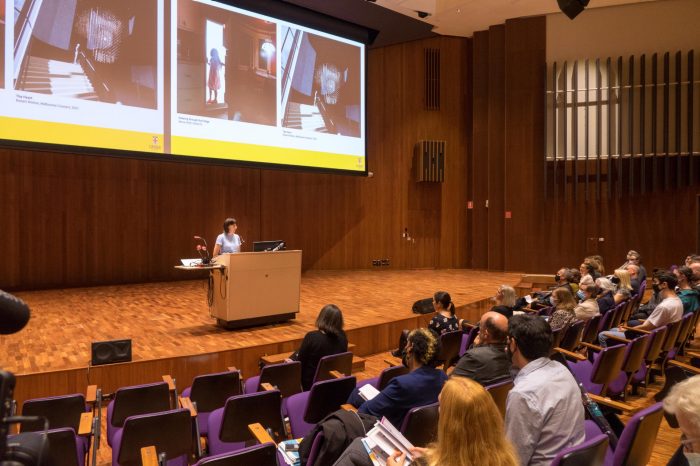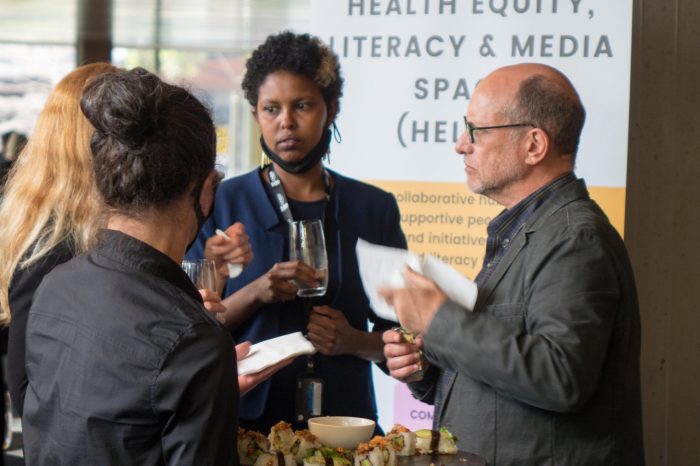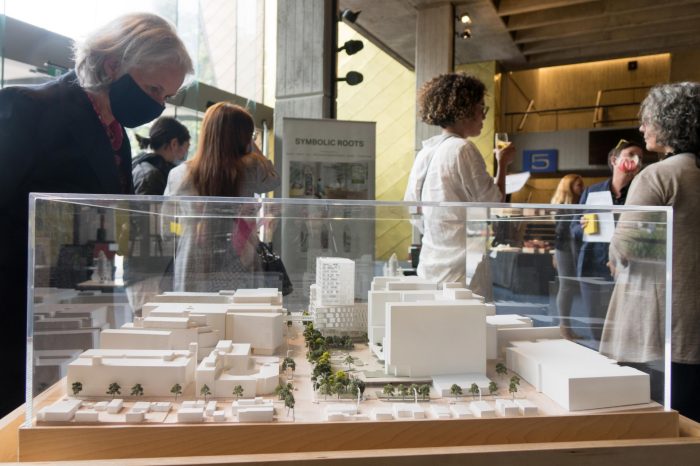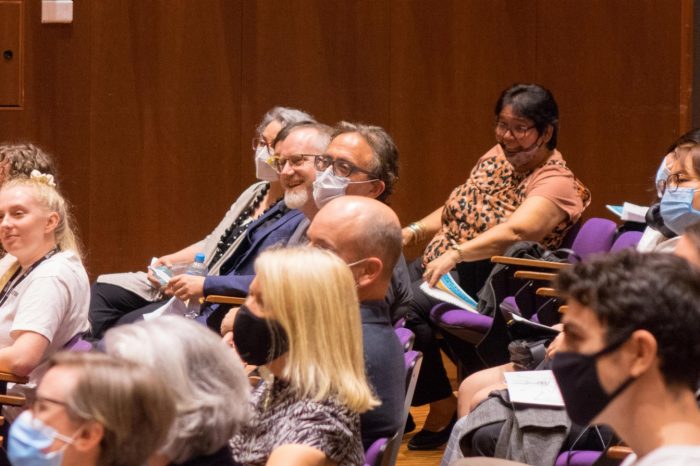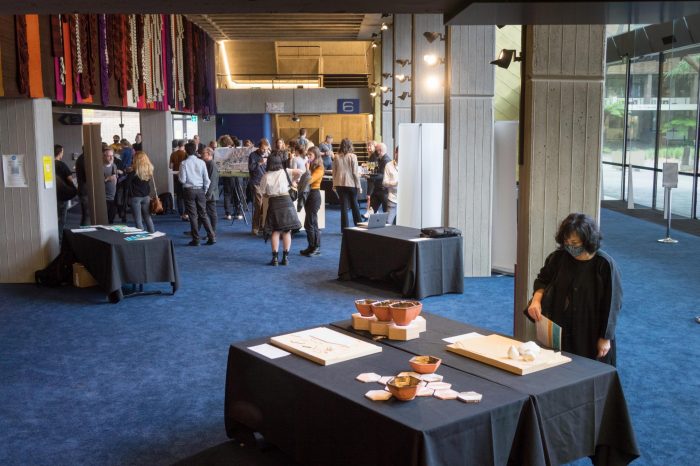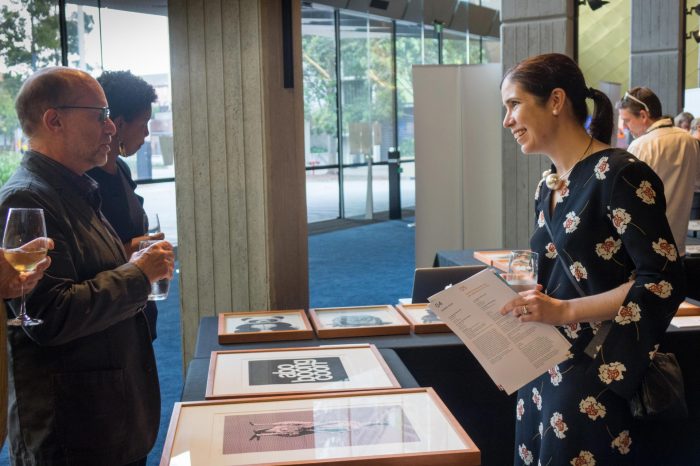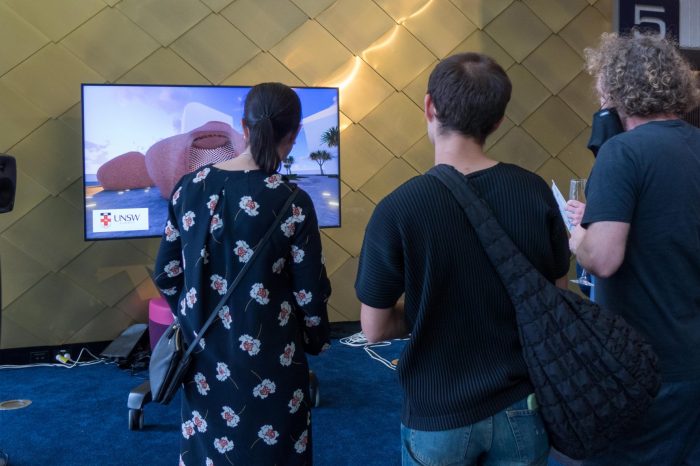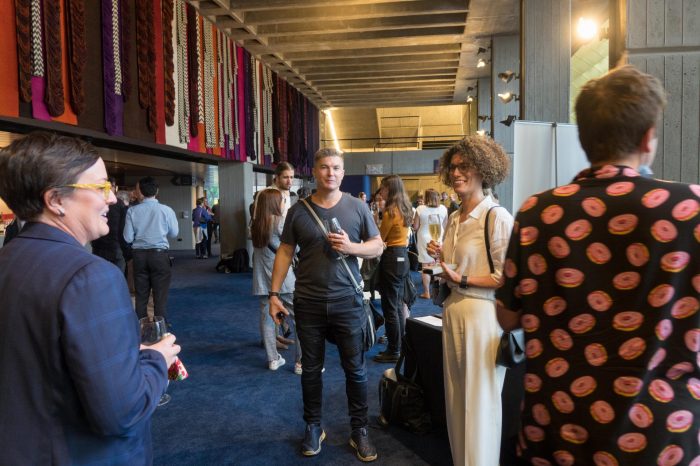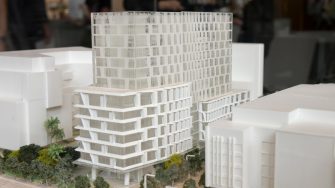
Facts & figures



ADA Innovation Hub fosters collaboration with the Randwick Precinct
Text reproduced from Inside UNSW, Edition 20, 2021
A collaboration between the UNSW Arts, Design & Architecture (ADA), Health Precincts (UNSW Medicine & Health) and Estate Management, the ADA Innovation Hub x UNSW Health Translation Hub (HTH) project saw teams awarded a series of $8,000 grants, facilitated by the ADA Innovation Hub. These grants were used for research, prototyping and the development of project proposals to be considered in the design of the new HTH building.
In keeping with the ADA Innovation Hub's vision to curate interdisciplinary teams of staff and students from across the faculty to solve problems through creativity, collaboration, and inclusion the HTH project brings together educational and medical researchers, clinicians, educators, industry partners and public health officials.
The UNSW HTH will support the translation of research and education into improved patient care. This collaborative approach will deliver better health outcomes to the community. In addition, it will seamlessly connect the University with public health and enable UNSW to compete at the forefront of public health research and education.
Dean of UNSW ADA, Professor Claire Annesley, said the collaboration will harness the diverse expertise available across the Faculty.
“The Health Translation Hub is a hugely important strategic initiative for UNSW. The design and integration of the building into the wider precinct is a complex project for the University and our health partners. As a faculty, we were thrilled to be part of this unique opportunity,” she said.
“By working through ADA’s Innovation Hub, we were able to bring together a unique mix of expert knowledge from across our disciplines. Our staff and students were asked to think creatively about the possibilities and recommend some ideas for the University to consider in its planning.”
“We’re looking forward to seeing the outcome of these initiatives and are excited about the interdisciplinary approach and the potential of the real-word application of these outcomes. The HTH should not be seen as just a building, but a place that will drive UNSW’s vision to realise health benefits,” said Niki Douglas, Director of Development, UNSW Estate Management.
The five projects awarded considered built form and urban design concepts around the building and its open space. They also examine program design that addresses the use of the space, including social and cultural interpretations.
Project teams had to include academic and professional staff, at least one student and representation from at least two UNSW ADA schools. Students involved on the projects received Creative Confidence Grants.
From August to November teams used the funding to develop full Project Proposals which were presented at the inaugural ADA Innovation Hub Project Showcase held in December 2021 at the Sir John Clancy Auditorium, UNSW Sydney.
Read about the five Project Proposals and Project Teams below.
Breathe
Breathe, animates the HTH precinct with gentle movements of light and sound to create the sense that the environment is breathing. Quiet shimmers of light and sound wisp across the pathways and walls, and are pulled into the artwork’s centre: a cluster of purpose built relaxation spaces. Breathe creates a spectacle, a calming environment, and a cause to think about all the ways in which breath connects us with each other and the world.
Staff: Oliver Bown (Project Lead), Kate Dunn, Katherine Bond, Adam Hulbert, Nichola Jephcott, Simon Trevaks, Madi King, Charlotte Firth, Daniel Yu, Alex Tohidi
Students: Darcy Altavilla, Joanne Chiang, Marco Rinaldi, Ailish Power, Arno Zhang
Collaborators: mili mili (consultation on a schedule for Indigenous community consultation and engagement), Kurt Mikolajczyk (audio system programming), Mitch Allen, Neelam Gopalani and Rebecca Cadorin (Arup)
Team members representing 'Breathe' pictured left to right include: Oliver Bown, Darcy Altavilla, Ailish Power, Joanne Chiang, Charlotte Firth, Katherine Bond, Kate Dunn, Adam Hulbert and Simon Trevaks. Image: Martin Fox.
Scale model of the artwork's centre: a cluster of purpose built relaxation spaces. Image: Martin Fox.
Health Equity and Literacy Media Space (HELMS)
HELMS has been conceptualised as both a physical and virtual space as part of UNSW’s Health Translation Hub, and extending beyond. The space will provide media facilities and support to organisations and community members working with culturally and linguistically diverse communities to promote health equity and to increase health literacy through culturally safe means. Areas of support which HELMS might provide include developing culturally safe health messages that reach culturally and linguistically diverse communities, creating health and media content, sharing information, facilitating advocacy and networking.
Together such initiatives would help reinforce social capital and inclusion and promote links between culturally and linguistically diverse communities, civil society organisations, health services and UNSW. HELMS seeks to build on opportunities made available through the Health Translation Hub to help devise solutions to the health challenges faced by culturally and linguistically diverse communities.
Staff: Anthony Zwi (Project Lead), Hani Abdile, Valentina Baú, Dean Utian
Students: Keren David, Kayla Lochner, Loc Nguyen
Collaborators: Justin Koonin (ACON)
Hani Abdile and Anthony Zwi presenting at the ADA Innovation Hub x UNSW Health Translation Hub Project Showcase 2021. Image: Martin Fox.
Team members representing 'HELMS' pictured left to right include: Hani Abdile, Valentina Baú and Anthony Zwi. Image: Martin Fox.
Symbolic Roots
Symbolic Roots is at the same time a built form and an urban infrastructure design concept providing wayfinding and social intervention. The project consists of several interactive pods and wall-mounted elements. These are placed in the ground floor foyer and levels 1 and 2 of the Health Translation Hub at the Randwick Hospital Campus. These elements work together with a range of native plant animations, nature sounds, an interactive smartphone app and a website. Through these components, an awareness of Nature and our deep connections to it is raised, contributing to a calmer, more informed visitor. The pods allow visitors to find their way withing the building, to discover events that are on, to explore art works on display within the building, to learn about Indigenous knowledge and native plants.
Staff: Karen Kriss (Project Lead), Oya Demirbilek (Project Lead), Ant Banister (Sound Consultant), Danielah Martinez (Lead Designer)
Students: Thomas Bowman, Jungwon Eom, Nguyen Vy Luong, Olivia Spurling
Collaborators: Tilt Industrial Design (Industry Partner), Mighty Nice (Animation Consultant), 22MILES (Wayfinding, App & Website Consultant), Scott Brown (Well-being Hub & Sensory Garden Consultant), Min Kong (Wayfinding Strategic Consultant), Aunty Maxine Ryan (First Nations Consulatant and local Dharawal woman from La Perouse), Joshua Yasserie (First Nations Consulatant and Wiradjuri man, Graphic Artist and Animator)
Team members representing 'Symbolic Roots' pictured left to right include: Scott Brown, Oya Demirbilek, Jungwon Eom, Aunty Maxine Ryan, Thomas Bowman, Ant Banister, Olivia Spurling, Danielah Martinez, Nguyen Vy Luong and Karen Kriss. Image: Martin Fox.
A 1:10 scale 3D printed representation of a ‘Symbolic Roots’ wayfinding pod with silhouettes of two people. Image: Martin Fox.
Moment-us
Smart green spaces and places can have a ‘moment-us’ impact in and around the Health Translation Hub, providing a series of ‘moments’ of beauty and delight for staff, students and the wider community, producing food, managing waste and piloting innovative technologies linked to interactive visual displays as well as collecting evidence to inform the Precinct-wide rollout of interactive green infrastructure…
The Moment-us project proposal incorporates both a physical and a programmatic dimension.
The proposed physical intervention involves establishment of interactive / edible green infrastructure and associated technologies which we envisage as a distributed network comprising both outdoor and building-integrated spaces.
Specifically, the objectives of the project are to establish:
1. A rooftop urban farm as a restorative retreat for staff and a teaching and research resource, utilising ‘Smart Planter Box’ technology (on display in the foyer);
2. Stress relieving indoor green walls, at the entry point and also in waiting rooms, to support patients, their families and friends;
3. Interactive visual technologies, including LED animations, wayfinding signage, screens and a QR code linked smartphone app;
4. Outdoor sensory and medicinal gardens, accessible to all including visitors to the HTH and the local community;
5. Integrated waste management system, to ‘close the loop’ with the urban farm.
The proposed program intervention will utilise this green infrastructure network to support a range of qualitative and quantitative research, including investigation of relationships between environmental practice and human health and wellbeing.
Staff: Paul Osmond (Project Lead), Kate Bishop, Linda Corkery, Rebecca Green, John McGhee, Felicity Rawlings-Sanaei, Cathy Sherry
Students: Latham Brook
Collaborators: Majed Abuseif (Griffith University), Hekmat Hozilah (Industry), Homa Rahmat (Industry)
Kate Bishop and Rebecca Green presenting at the ADA Innovation Hub x UNSW Health Translation Hub Project Showcase 2021. Image: Martin Fox.
Team members representing 'Moment-us’ pictured left to right include: Felicity Rawlings-Sanaei, Kate Bishop and Rebecca Green alongside a scale model of their proposal to establish interactive / edible green infrastructure and associated technologies for the HTH. Image: Martin Fox.
Site first: site-specific and site-responsive art for HTH
The goal of this project was to generate and assemble a cohesive collection of fine art that responds directly to the HTH site and its function.
Featured artworks include:
* Objects I-VI (Allan Giddy)
Wood, Perspex, lighting
This first HTH deluxe version is solar powered and sensing. Radiological artifact mounted then displayed in bespoke lit case, described by young boy from Bondi (1st test).
* Reproductive Behaviour of Fish (Amelia van der Laan de Vries)
Fineliner pen on paper
Taxonomic-style drawings of Carl Linnaeus (the father of taxonomy) in stages of reproductive courtship with a zebrafish. The first two of a series of five drawings will be shown.
* Narratives of Place, Home, and Wellbeing (Amelia van der Laan de Vries)
Fineliner pen on paper
Five small drawings, each based on an interview with an individual about what home means to them, and the memories and objects that remind them of home.
* HTH Voices (Jack Poppert)
Parabolic speaker, recorded interview excerpts
The outcome of the HTH Voices project is two sound artworks: HTH Voices: Healthcare Workers and HTH Voices: Construction Workers. In the former, culturally and linguistically diverse healthcare workers will describe their linguistic and cultural knowledge – and their personal experience – with regards to key themes of the concept ‘health’; in the latter artwork, construction workers will be interviewed about their understanding of themes related to the concept of ‘construction’.
Staff: Allan Giddy (Project Lead), Anikó Hatoss, Michael Kempson, Damien March
Students: Jack Poppert, Amelia van der Laan de Vries
Allan Giddy presenting at the ADA Innovation Hub x UNSW Health Translation Hub Project Showcase 2021. Image: Martin Fox.
Team members representing 'Site first’ pictured with Allan Giddy's artwork 'Objects I-XI' from left to right include: Allan Giddy, Damien March, Michael Kempson, Anikó Hatoss, Jack Poppert and Amelia van der Laan de Vries. Image: Martin Fox.

